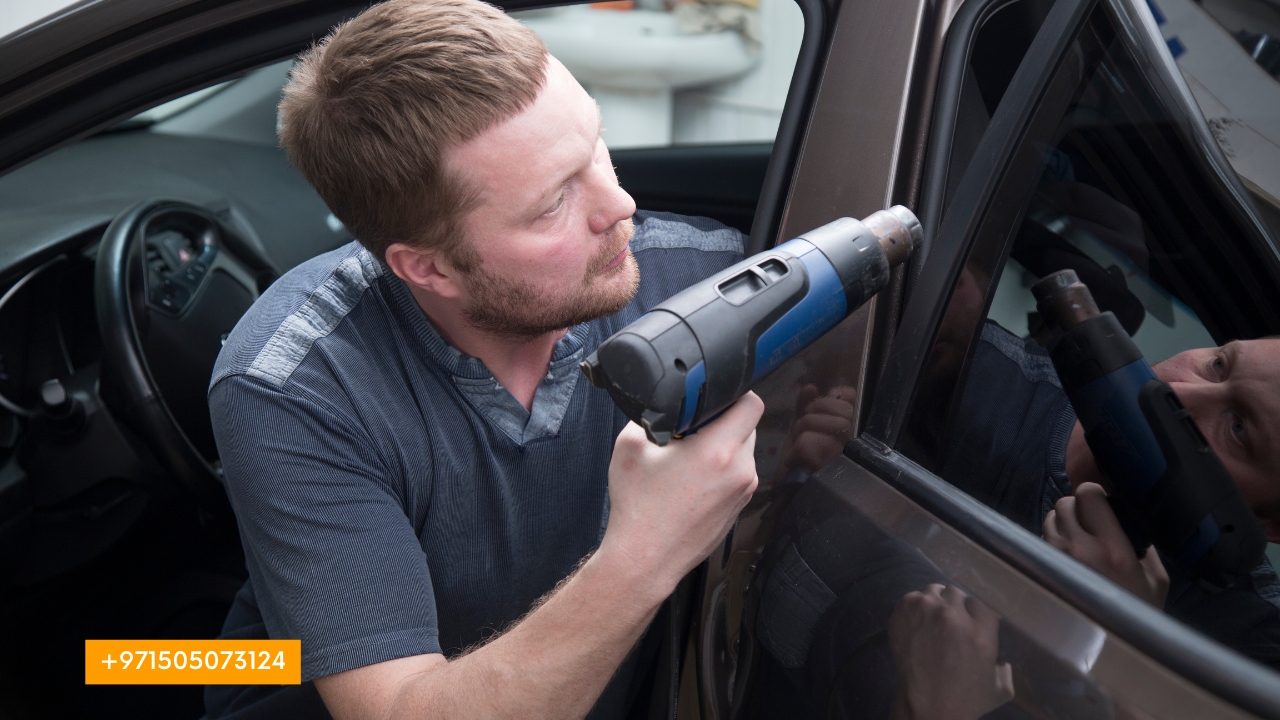Car window tinting refers to the process of applying a thin film on the car window to reduce the amount of heat and ultraviolet (UV) light entering the vehicle through the window glass. It enhances the privacy of the car, reduces glare, maintains the cooler temperature of the interior, and increases the overall aesthetics of the car.
This article will discuss various types of window tinting films, factors to consider while selecting the right ones, and proper maintenance and care tips for them.
Types of Window Tinting Films
1. Dyed Tint Film
It is one of the most commonly used tinting films and is composed of an adhesive layer, a protective layer, and a layer of dye between these two. It is cost-effective and is used primarily to enhance privacy and reduce glare and sunlight. But the dye material of the film is heat absorbent rather than heat repellent making the interior of the vehicle hotter.
Moreover, these films tend to fade and discolor easily over time. It is advisable to consider both pros and cons of these films before selecting them.
2. Metalized Tint Film
There lie tiny metal particles between this film’s adhesive and protective layers. Due to the inherent property of metal particles to reflect heat and sunlight, these films create a cooler interior and provide excellent protection against UV rays.
These films are more durable than dyed tint films. but one potential drawback of using them is that metal particles interfere with the radio, mobile, and GPS signals making the communication system difficult inside the vehicle. Moreover, these are also expensive and require professional installation.
3. Carbon Tint Film
These films are typically more effective in blocking infrared and UV light than dyed and metalized films. This keeps the interior of the car cool, preventing excessive load on its HVAC system. These films are durable and enhance privacy without interfering with the electronic signal transmission.
But the carbon particles create glare and haze due to their large size and these films are expensive too.
4. Ceramic Tint Film
These films are composed of ceramic particles that have the highest ability to reflect harmful UV and infrared rays. These are durable and maintain adequate privacy with minimal or no interference with electronic signals. These are more expensive than other options. But it will be a lifetime investment for you as the benefits outweigh their cost.
5. Hybrid Tint Film
These tint films are made by combinations of metallic, ceramic, dyed, or carbon particles. The characteristics and features of the film may vary depending on the combination used. For example, a hybrid film of dyed and carbon particles will absorb and dispense the solar heat while that of metallic and ceramic particles will reflect the infrared radiation. Their pros and cons and price range don’t differ greatly from other tint films
6. Color Tint Film
These films come in a variety of colors like Blue, Charcoal, Green, and Black Blue and are used mainly for aesthetic enhancement of the car such as in automobile shows. These colors are prone to absorb radiation and heat and make the interior of the car hotter. It makes them an unsuitable option for warm areas.
Factors to Consider When Choosing Window Tint Film
Car window tinting offers several benefits, including enhanced privacy, protection from harmful UV rays, reduce heat, and glare reduction. However, choosing the right window tint for your car can be a daunting task. With various options available in the market, it’s important to consider several factors before making a decision.
A. Familiarize Yourself with Local Regulations:
Research local laws and regulations regarding window tint films to avoid any penalties. Each region may have specific restrictions on tint darkness, reflectivity, and placement on certain windows. By complying with the local regulations, you can avoid legal consequences, fines, and the need for costly removal.

B. Identify Your Needs:
Determine the level of privacy you want to achieve in your car and select the one that fulfills your needs. Understanding your priorities will help you choose the appropriate window tint that caters to your specific requirements. If the climate in your area is hot like in Dubai, select ceramic or carbon tint films to avoid excessive heat development inside the car.
C. Consider Tint Darkness:
Window tints are available in varying darkness levels, measured as a percentage. The lower the percentage, the darker the tint. It’s important to balance your desired level of privacy and aesthetics with local regulations. Be mindful that darker tints may reduce visibility at night, especially for the driver.
D. Evaluate Tint Quality:
Investing in a high-quality window tint ensures longevity and optimal performance. Consider the following aspects when evaluating tint quality:
- Color Stability: Look for tints that maintain their color over time without fading or turning purple.
- Heat Rejection: Check the tint’s specifications for its ability to reduce heat transmission. Higher-quality tints typically have better heat rejection properties.
- UV Protection: Ensure that the tint offers excellent UV protection to safeguard yourself and your car’s interior from the damaging effects of the sun’s rays.
- Scratch Resistance: Opt for tints that are scratch-resistant to maintain a clear and unblemished appearance.
- Manufacturer Warranty: A reliable manufacturer should provide a warranty that covers any potential defects or issues with the tint.
Maintenance and Care Tips
- Avoid rolling down the windows for a couple of days after installation of the films to ensure maximum adherence between films and window glass.
- Clean the window tint films regularly using a soft microfibre cloth or sponge with a mild cleaning solution. Clean the tints gently without applying too much force.
- Avoid using harsh chemicals such as ammonia-based solutions or abrasive cleaning tools as these may damage the films and decrease their life.
- If the tints are peeling or there is a bubbling issue, you may need to consult a window tint professional. Attempting to fix it by yourself will end up causing more damage.
- Avoid using harsh chemicals such as petroleum and sharp instruments such as knives or scissors near window tints as these may damage or degrade them.
Quick Read: Signs You Need Professional Car Recovery Assistance
DIY Window Tinting vs. Professional Installation

DIY (do it yourself) window tinting can be cost-effective, flexible, and gives you a lot of learning experience but you should have plenty of skill, knowledge, and time for it. Without adequate experience, there is always a higher chance of errors such as bubbling, misalignment, or creases.
Getting the installation done by highly experienced professionals provides you with an errorless tint application, warranty or guarantee, and compliance with regulations. But you should have a flexible budget for it. It is recommended always to go for professional tint installation to avoid any error in the procedure and damage to the tints.
FAQs
How to Choose the Best Window Tint Percentage for Car in Dubai
In Dubai, the legal limit for window tint is 50%. However, many individuals opt for lighter tint percentages such as 30% or 20%. Window tint offers several advantages, including keeping the car cooler in the summer, which saves on air conditioning costs. It also protects the car from harmful UV rays, which can lead to skin cancer and premature aging.
What is the best car tint for night driving?
For optimal visibility during night driving, it is recommended to choose a light car tint with a visible light transmission (VLT) ranging from 35% to 50%. This tint level helps reduce the contrast between the car’s interior and the outside, resulting in clearer visibility of objects.
Remember to check your local laws regarding window tint legality as it varies between states and regions. Ensuring compliance with local regulations is essential before applying tint to your car windows.
Conclusion
Window tint films prevent the development of excessive heat inside your car by reflecting harmful ultraviolet and infrared lights, add to the privacy and aesthetics of the car, and are gaining popularity due to these benefits. This article has discussed various types of car window tint films, factors to consider while selecting a specific type, their installation preferences, and care and maintenance tips. We hope that you will find this information useful regarding the betterment of your vehicle.





